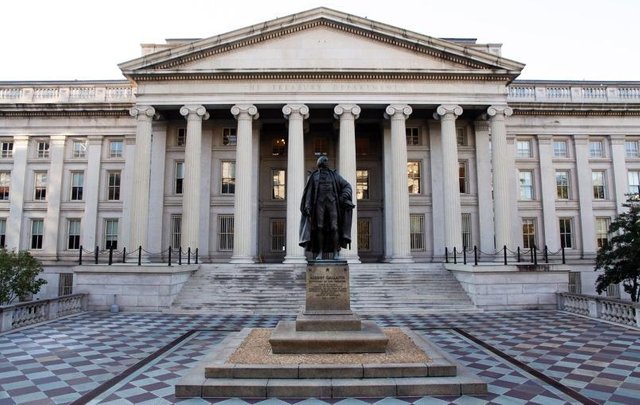
The United States debt ceiling is a limit placed on the amount of money that the federal government can borrow. This is done by placing a cap on the amount of national debt that can be issued by the US Treasury. About 99.5 percent of the debt is covered by this ceiling, but $238 million in United States Notes and $74 billion owed by the Federal Financing Bank as of September 2016 are not covered.
Because the ceiling applies to the total national debt rather than to annual deficits, and expenditures are authorized by separate legislation, the debt ceiling does not directly limit government spending. As the Government Accountability Office explains, “The debt limit does not control or limit the ability of the federal government to run deficits or incur obligations. Rather, it is a limit on the ability to pay obligations already incurred.”
When this occurs and the ceiling is not increased by legislation, the Treasury must resort to “extraordinary measures” such as suspending investments into federal employee retirement funds or exchanging Treasury securities for non-Treasury securities. Should such measures be exhausted before Congress agrees to raise or suspend the ceiling, a default on at least some of the national debt would occur. Most mainstream economists believe that this could cause an economic depression as well as a financial crisis.
Whether the nature of this ceiling should be altered and whether such a limit should exist at all are subjects of debate among economists and political commentators. This article will overview the history of the debt ceiling, make the case that it should be eliminated on both practical and moral grounds, and deal with common objections to elimination.
History
Article I, Section 8 of the United States Constitution gives Congress sole authority to borrow money on national credit. Between 1788 and 1917, Congress would pass legislation to authorize each bond issue by the US Treasury, with the particular amount specified in each legislative act. This would authorize specific loans in some cases, while in other cases the Treasury would be given discretion over which type of debt instrument to issue for specific purposes. Except for a short time in late 1835 and early 1836, the federal government has continuously had a national debt. Although there were parliamentary procedural rules concerning debt limits, there was no debt ceiling in the current form until 1917.
In 1913, the Sixteenth Amendment and the Federal Reserve Act both became law, which greatly expanded the taxing and spending capabilities of the federal government. As originally defined, the Federal Reserve was not allowed to purchase debt instruments from the US Treasury because members of Congress understood the fiscal danger that could arise from granting such permission. The desire for financial flexibility regarding American involvement in World War I led Congress to pass the Second Liberty Bond Act of 1917. This Act allowed the Treasury to issue bonds and take on other debt without specific Congressional approval, and allowed the Fed to purchase Treasury instruments. The debt ceiling was created as part of the deal to pass these changes, and took the form of limits on the aggregate amount of debt that could be accumulated through each category of debt, such as bills and bonds.
In 1939 and 1941, Congress passed the Public Debt Acts, which establish an aggregate limit on nearly all federal debt. Since then, the mechanism for raising the debt ceiling has been to amend these acts. The 1939 Act consolidated the separate limits from the 1917 Act into one limit, while the 1941 Act raised the debt ceiling to $65 billion, eliminated the tax exemption of interest and profit on government debt, and consolidated almost all government borrowing under the US Treasury. The Act was amended to raise the limit in each of the next four years, then the limit was reduced from $300 billion to $275 billion in 1946. Increases resumed in 1954, and there have been 72 increases and four decreases since then, with no decrease since 1963. As such, the debt ceiling has usually been a mere formality. After the Budget and Impoundment Control Act of 1974 created more opportunities for Congress to hold debates and hearings on the federal budget, the debt ceiling became less useful as a budgetary tool.[1] From 1979 to 1995, the Gephardt rule was in effect, which was a parliamentary rule that deemed the debt ceiling raised whenever a budget was passed, effectively nullifying the debt ceiling during that time. This rule was removed during the resolution of the 1995-96 government shutdown.
Treasury first implemented extraordinary measures on December 16, 2009 to avoid a government shutdown. Due to the lack of normal annual budgets during the Obama administration, Congressional Republicans used the debt ceiling as leverage for deficit reduction in 2011. This nearly caused a sovereign default, with Standard and Poor's downgrading the United States credit rating and the Dow Jones Industrial Average dropping 2,000 points in late July and August. The Government Accountability Office estimated that this incident raised borrowing costs for the government by $1.3 billion in 2011, and the Bipartisan Policy Center extrapolated this estimate to $18.9 billion from 2011 to 2020. The debt ceiling was reached again at the end of 2012, which led to the Treasury adopting extraordinary measures again, as well as far more absurd measures being proposed.
Read the entire article at ZerothPosition.com
References:
- Kowalcky, Linda W.; LeLoup, Lance T. (1993). Congress and the Politics of Statutory Debt Limitation. Public Administration Review. 53 (1): p. 14.